What does trying to be a bird say about being a human?
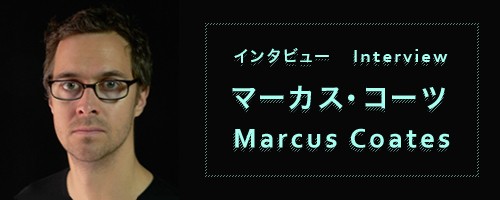
The Daiwa Anglo-Japanese Foundation Art Prize was launched in 2008 with the objective of introducing talented British contemporary artists to Japan by offering them their first Japanese solo show. The 2009 winner was Marcus Coates, and his show was staged at the Tomio Koyama Gallery in November. Also in Tokyo for the occasion was the panel chair for the prize. We listened in as he probed the artist about his views on human beings, a subject fundamental to his unique creative practice.
Interviewer: Jonathan Watkins (Director of the Ikon Gallery)
Text: ART iT
– Let me start with a bit of background: I was invited by the Daiwa Anglo-Japanese Foundation to be part of the jury for the Daiwa Foundation Art Prize before it was clear what the conditions of the prize should be, other than contemporary art. The jury members all felt that we’d attract more interesting artists if it were completely open, if any British artist doing anything could apply – the only condition being that they hadn’t had a solo exhibition yet in Japan. And almost a thousand people applied. So Marcus Coates is one in a thousand – literally. What made you apply?
I got the notice from an organization called Grizedale Arts who I went to Japan with in 2006 to create work for the Echigo-Tsumari Triennial and the Ikebukuro Art Festival. I’d been looking for a way to come back to Japan ever since because the experience had such a huge effect on all the artists who came over. Another thing that attracted me to working and showing my work in Japan is my interest in the idea of a universal language, a language beyond language. And a lot of that involves animals. So I saw Japan as a very interesting to place to work in that way, where language needn’t be a barrier.
– What was it that led you to the kind of work you make?
The idea was to think about how we define being human. My big interest always, from the time I was a child, was in animals and birds, and more recently in how we use nature to define of ourselves. We say nature is kind, for example, to suggest that we are benevolent. And in this way, we use it to reflect ourselves. Or we sometimes use it in contrast – by saying animals are bad, humans are good – to define ourselves in that way. I wanted to look at these relationships and how are they made. Some are romantic, some more objective and scientific. So it’s been an exploration of self-definition really. Am I bird? Is it possible to be a bird? And what does trying to be a bird say about being a human?
True nature revealed by transforming contexts
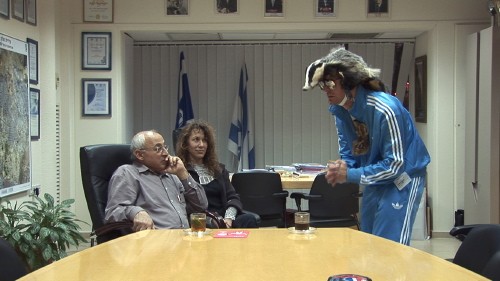
The Plover’s Wing 2008
Photograph
– What do you think of the Russian artist Oleg Kulik’s work and how it relates to yours?
To me his work is about a transgression of being human, quite often a political transgression. So being a dog, for example, in the street, naked, feels like he’s trying to transgress the rules that define us in society. I don’t think I’m so interested in those cultural rules.
– Although you are transgressing as well. In The Plover’s Wing for instance, when you go into the office of the Israeli politician wearing a stuffed badger’s head, you are completely transgressing the rules of meetings. This person is bemused, but also very aware of being watched, so he adopts certain behavior patterns. It’s like two incommensurable worlds meeting in his office. It’s such a wonderful, tense scenario.
I’m interested in that transformation, whether that’s transgressive or not, I’m not sure, although I suppose it is transgressive of manners and etiquette.
– Also in Out of Season, there’s a transgression as you translate a behavior pattern by taking it into the wrong context. In this case, it is not you, but someone else.
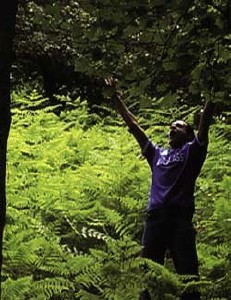
Out Of Season 2002
Digital video 10 mins, actor Andy Coltrane
© Marcus Coates
Yes, he was a Chelsea football fan singing his football songs surrounded by birdsong in a beautiful English forest with the sun shining on him – all very beautiful and wonderful and the birdsong very romantic and lovely. But his songs are horrible: they’re racist, and homophobic, and very aggressive. He was boasting about being a Chelsea fan and then saying horrible things about all the other football teams that he wasn’t – defining his territory in a very aggressive and warlike way. And that’s exactly what the birds are doing. They’re all male birds; they’re all interested in territory and instead of fighting, they’re singing to show their strength. And they’re all showing their colors, just like he’s showing his shirt. So there is a total parallel there, which I’ve recently understood as being a convergent evolution. We’ve evolved to a cultural activity that at the moment is exactly the same as the cultural activity that the birds have evolved to do.
In both of those works the environments are incongruous to the activity going on. I was trying to show the most remarkable contrast I possibly could, but in fact also show the most remarkable similarity.
Seeking oneself through our relationship with nature
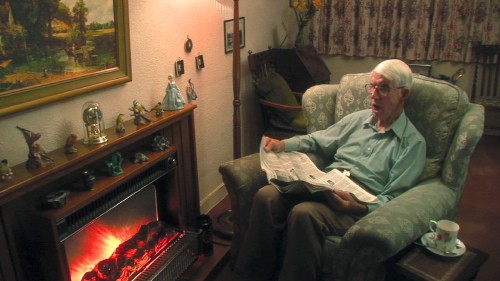
Dawn Chorus 2006
High-definition video, 20 mins looped
– Do you see human beings as animals?
Yes. However far we feel we are removed from nature, I’m continually surprised that despite ourselves, we are innately linked to it. The humans making birdsongs in Dawn Chorus, for example. The way we’re so similar to birds, the way we make sounds and take the breaths, is amazing. The only difference between us and these birdsongs is speed. The only difference between us and whale song is speed. You speed up whale song a certain amount of times and it turns into birdsong. You speed up birdsong and it turns into insect. There’s this commonality between all species that is very interesting.
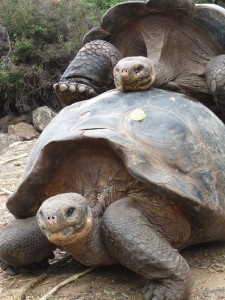
Intelligent Design 2008
DVD 8 min. looped
– Even the Galapagos tortoises in Intelligent Design… These geriatric creatures hopelessly – particularly in the light of the fact that they are both male – trying to mate; there’s something incredibly sad about it. Then you’ve got these two tourists watching them, and it’s incidentally their behavior which is really quite riveting, you observe them with the eyes of a natural historian, their human behavior, their relationship…
Here you have these giant tortoises that are maybe 150, 180 years old; they’re ancient things. They’re about as far away from humans as possible, I think. But even though they are so far away, we project our own sense onto them and their activity. We feel for them, we empathize with them, we feel there’s something familiar about what they’re doing – which of course there is. Their voices are very familiar – this grunt when their having sex, is very human. So they become human, really; we make them human. And then you see these two humans coming in and they’re like strange animals. It’s a strange reversal.
Marcus Coates
Born 1968 in London. Uses a wide range of media including video, installation, and performance to create works that explore the fundamental relationship between animals and humans. Presented Dawn Chorus at the 2007 Venice Biennale and exhibited in the 2009 Tate Triennial. In Japan, he participated in the Grizedale Arts Seven Samurai project as a segment of the 2006 Echigo-Tsumari Art Triennial. He spent one month in Niigata’s Tokamachi and presented a performance in Tokyo, which led to a performance at Liverpool Biennial 06. As winner of the 2009 Daiwa Foundation Art Prize, he staged his first solo show in Japan at Tomio Koyama Gallery in November 2009 and gave a related artist talk and performance at Academy Hills in Roppongi.
Jonathan Watkins
Director of Ikon Gallery, Birmingham. Assumed his current post following curatorial posts at the Chisenhale and Serpentine Gallerys in London and as artistic director of the Biennale of Sydney in 1998. Has curated exhibitions for the Venice Biennale, and for the Hayward Gallery and Tate Britain in London. He served at the chair for the 2009 Daiwa Foundation Art Prize.
Courtesy The Daiwa Anglo-Japanese Foundation / Tomio Koyama Gallery
